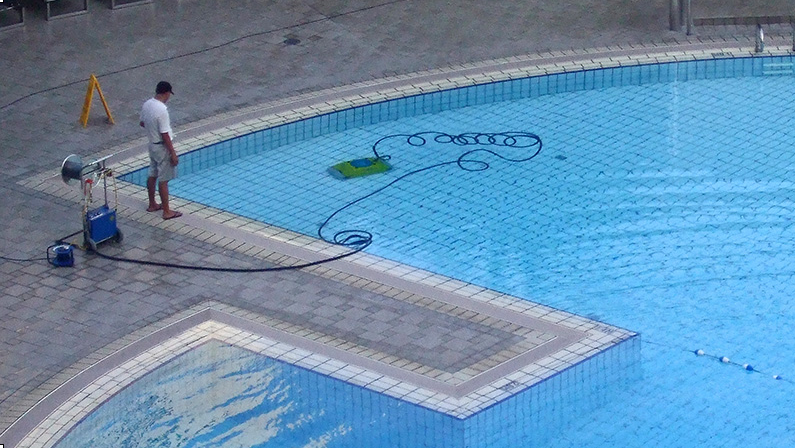Stripping off and plunging into a crystal clear swimming pool is where a holiday starts for most of us, but do you know how to spot the signs that all might not well in the water?
Dreaming of that cool, refreshing plunge into a picture-perfect pool on your trip? Hold on! Before you take the leap, ensure the water isn’t hiding any unwelcome guests: bacteria. While most pools are well-maintained, vigilance is key, especially since even a sparkling surface can harbor harmful microbes. Fear not, fellow traveler! This guide equips you with the knowledge to assess your holiday pool’s safety and beat the bacteria blues.

Keep it clean… here’s how to check your pool’s safe Image credit
Is the water crystal clear?
Alright, admit it, have you been itching to jump in? Before you cannonball your way to fun, let’s take a quick peek. Can you see the bottom clearly? Is the drain like a beacon calling your name? Remember, sparkling water can be deceiving, so stay tuned for some crucial pool safety tips before making a splash…
Touch the water, poolside and any other equipment around it
Put your hand in the water, remove and rub your fingertips together? Is there a decent amount of resistance or does it feel slimy? How about the poolside and other equipment? See if it’s squeaky clean of decidedly oily. Too much ‘gunk’ can mean the chlorine is not working effectively – meaning there could be harmful bacteria enjoying a swim.
Cloudy, murky water?
Murk could be a sign that the pool’s chemical balance has gone awry, leaving the water vulnerable to bacteria or algae. It could also mean contaminants such as flood water might have entered the pool. Alternatively, poor circulation might be causing the water to stagnate. This could mean a filter is blocked or the chemicals need looking at. Inform the holiday rep and avoid the pool for at least a day as the water is treated.
Have you seen a member of staff taking water samples?
A busy, well-run holiday swimming pool is likely to have someone taking samples every three or four hours – so witnessing a member of staff crouching over the edge and filling a small container with water is a good sign of active management. If not, simply ask the resort manager for the result of the latest test and check the time and date. These should be carried out at least once a day.
Check the water circulation is working
Pools have filters, but can only do their job if the water actually gets to them. When in the pool, look for the circulation jets and make sure you can feel water being forced from them. To be working efficiently, there should be a strong blast hitting your body when you stand in front of it. A weak trickle of water could mean something is blocked – leaving pool water to stagnate and become a breeding ground for tummy-bashing baddies.
Look out for potential sources of contamination
People are a leading suspect here, but pools aren’t much use without them. However, look out for showers near to the pool and how many people use them before taking a dip – this can help gauge the overall health of the pool water.
Look also for how many babies are swimming in swimpants – waterproof nappies – and how many are simply being allowed to bathe in standard nappies. Many pools will ban the use of non-swimpant nappies because they allow bacteria to leak out with ease. You’ll be within your rights to mention this to non-conforming parents, or the pool owner.
You should also look out for pets being allowed to jump in and splash around – this might be ‘cute’ but it’s also rampant source of bacteria. Look for the pool rules which are likely to ban such actions and act accordingly. Along with live animals, keep an eye out for dead creatures – such as lizards and frogs – lying in the pool and ensure staff remove them and act on any contamination.
Faeces in swimming pools
If a young child has the unspeakable ‘accident’ while you’re in the pool, make sure you get out immediately and inform whoever is responsible for its operation. They should remove all ‘matter’ with a net before draining the pool if practical, or add a concentrated dose of chlorine to the pool. No one should re-enter the water for at least half an hour after this. The pool manager should ensure chlorine levels are safe before giving the okay to resume swimming.
There’s a strong smell of chlorine
Many people wrongly believe this is a sign of too much chlorine, when it actually means there’s likely to be too little. A lack of chlorine – which kills the bugs – allows compounds to form which make the smell, which can irritate your nose, eyes and skin. If this is the case, then it’s probably time to head to the beach instead.
Test the pool water for bacteria, yourself
The Watersafe Bacteria Test is a rapid test kit that detects the presence of bacteria in swimming pools and spas. It’ll detect the presence of E.coli, Pseudomonas aeruginosa, species of Shigell, Enterobacter and many other equally unpleasant varieties of bacteria. It’s simple and fast to use, with handy test strips revealing on-the-spot results available within 15 minutes.
How much: £29.99 for 10 test strips.
Where: Find out more and order your swimming pool test strips here
